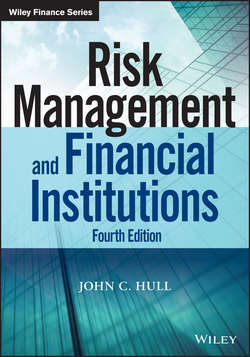Читать книгу Risk Management and Financial Institutions - Hull John C. - Страница 16
На сайте Литреса книга снята с продажи.
CHAPTER 1
Introduction
PRACTICE QUESTIONS AND PROBLEMS (ANSWERS AT END OF BOOK)
Оглавление1. An investment has probabilities 0.1, 0.2, 0.35, 0.25, and 0.1 of giving returns equal to 40 %, 30 %, 15 %, −5 %, and −15 %. What is the expected return and the standard deviation of returns?
2. Suppose that there are two investments with the same probability distribution of returns as in Problem 1.1. The correlation between the returns is 0.15. What is the expected return and standard deviation of return from a portfolio where money is divided equally between the investments?
3. For the two investments considered in Figure 1.2 and Table 1.2, what are the alternative risk-return combinations if the correlation is (a) 0.3, (b) 1.0, and (c) −1.0?
4. What is the difference between systematic and nonsystematic risk? Which is more important to an equity investor? Which can lead to the bankruptcy of a corporation?
5. Outline the arguments leading to the conclusion that all investors should choose the same portfolio of risky investments. What are the key assumptions?
6. The expected return on the market portfolio is 12 % and the risk-free rate is 6 %. What is the expected return on an investment with a beta of (a) 0.2, (b) 0.5, and (c) 1.4?
7. “Arbitrage pricing theory is an extension of the capital asset pricing model.” Explain this statement.
8. “The capital structure decision of a company is a trade-off between bankruptcy costs and the tax advantages of debt.” Explain this statement.
9. What is meant by risk aggregation and risk decomposition? Which requires an in-depth understanding of individual risks? Which requires a detailed knowledge of the correlations between risks?
10. A bank's operational risk includes the risk of very large losses because of employee fraud, natural disasters, litigation, etc. Do you think operational risk is best handled by risk decomposition or risk aggregation? (Operational risk will be discussed in Chapter 23.)
11. A bank's profit next year will be normally distributed with a mean of 0.6 % of assets and a standard deviation of 1.5 % of assets. The bank's equity is 4 % of assets. What is the probability that the bank will have a positive equity at the end of the year? Ignore taxes.
12. Why do you think that banks are regulated to ensure that they do not take too much risk but most other companies (for example, those in manufacturing and retailing) are not?
13. List the bankruptcy costs incurred by the company in Business Snapshot 1.1.
14. The return from the market last year was 10 % and the risk-free rate was 5 %. A hedge fund manager with a beta of 0.6 has an alpha of 4 %. What return did the hedge fund manager earn?
